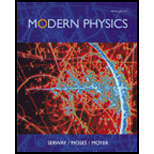
(a)
The explanation for the optical properties of metal.
(a)
Answer to Problem 1Q
Metals are opaque to visible light.
Explanation of Solution
Metals can absorb visible light. Again, visible can be scattered by the free electron inside the metal. As a result visible light can be easily absorbed by the metals.
Hence, Metals are opaque to the visible light.
(b)
The explanation for the optical properties of semiconductor.
(b)
Answer to Problem 1Q
Semiconductors are opaque to visible light however transparent to infrared.
Explanation of Solution
For semiconductor, the valance band can absorb the visible light as it has enough energy. As a result, the electrons can move from valance band to
On other hand, the infrared is not has enough energy to get absorb by semi-conductor. Hence,
(c)
The explanation for the optical properties of insulator.
(c)
Answer to Problem 1Q
Many insulators are transparent to visible light.
Explanation of Solution
The visible light has not has enough energy to get absorb by insulator. As a result, the electron from valance will not able to move to conduction band. Hence, the visible light can only pass through the insulator, like diamond.
Want to see more full solutions like this?
Chapter 12 Solutions
Modern Physics, 3rd Edition
- 12. A motorboat traveling 6 m/s, West encounters a water current travelling 3.5 m/s, South. a) Draw a vector diagram showing the resultant velocity, then determine the resultant velocity of the motorboat. b) If the width of the river is 112 m wide, then how much time does it take for the boat to travel shore to shore? c) What distance downstream does the boat reach the opposite shore?arrow_forwardLake Erie contains roughly 4.00⋅10114.00⋅1011 m3 of water. Assume the density of this water is 1000. kg/m3 and the specific heat of water is 4186 J/kg˚C. It takes 2.31x10^19 J of energy to raise the temperature of that volume of water from 12.0 °C to 25.8 ˚C. An electric power plant can produce about 1110 MW. How many years would it take to supply this amount of energy by using the 1110 MW from an electric power plant?arrow_forwardPls help ASAParrow_forward
- Pls help ASAParrow_forwardm m $2° 15. A truck is stopped at a red light. Once the light turns green, the truck accelerates forward at 1.75- that same instant, a car moving with a constant speed of 50 — passes the truck. a) How many seconds will it take for the truck to catch up to the car? S b) How many metres will the truck travel before it catches up to the car? Atarrow_forwardPls help ASAParrow_forward
- I need help adding more information to my study guide. This is subject is physics My topic : Emission Spectrum Target Material I need information on this topic but make it as study guide form and make 5 questions and include the answers.arrow_forwardAn electron and a proton are each moving at 755 km/s in perpendicular paths as shown in (Figure 1). Find the magnitude of the total magnetic force that the electron exerts on the proton. Find the magnitude of the total electrical force that the electron exerts on the proton.arrow_forwardTwo long, parallel wires hang by 4.00-cm-long cords from a common axis (see the figure (Figure 1)). The wires have a mass per unit length of 1.85×10−2 kg/m and carry the same current in opposite directions. What is the current in each wire if the cords hang at an angle of 6.00 ∘ with the vertical? Please explain all steps.arrow_forward
- The capacitor in (Figure 1) is initially uncharged. The switch is closed at t=0. What is the final charge on the capacitor? Please explain exactly what you doarrow_forwardThe slender rods have a weight of 6 lb/ft. (Figure 1) Figure Part A 1.5 ft- 1.5 ft 2 ft 1 ft 1 of 1 Determine the moment of inertia of the assembly about an axis perpendicular to the page and passing through the point A. Express your answer to three significant figures and include the appropriate units. IA = Value Submit Request Answer ? Unitsarrow_forwardYou have a summer internship at NASA and are working on plans for a new space station to be launched into orbit around the Earth. The design of the space station is shown. It is to be constructed in the shape of a hollow ring of mass 58,500 kg. The structures other than the ring shown in the figure have negligible mass compared to the ring. Members of the crew will walk on a deck formed by the inner surface of the outer cylindrical wall of the ring, with radius r = 125 m. The thickness of the ring is very small compared to the radius, so we can model the ring as a hoop. At rest when constructed, the ring is to be set rotating about its axis so that the people standing inside on this deck experience an effective free-fall acceleration equal to g. The rotation is achieved by firing two small rockets attached tangentially to opposite points on the rim of the ring. Your supervisor asks you to determine the following: (a) the time interval during which the rockets must be fired if each…arrow_forward
 Modern PhysicsPhysicsISBN:9781111794378Author:Raymond A. Serway, Clement J. Moses, Curt A. MoyerPublisher:Cengage Learning
Modern PhysicsPhysicsISBN:9781111794378Author:Raymond A. Serway, Clement J. Moses, Curt A. MoyerPublisher:Cengage Learning University Physics Volume 3PhysicsISBN:9781938168185Author:William Moebs, Jeff SannyPublisher:OpenStax
University Physics Volume 3PhysicsISBN:9781938168185Author:William Moebs, Jeff SannyPublisher:OpenStax Physics for Scientists and Engineers with Modern ...PhysicsISBN:9781337553292Author:Raymond A. Serway, John W. JewettPublisher:Cengage Learning
Physics for Scientists and Engineers with Modern ...PhysicsISBN:9781337553292Author:Raymond A. Serway, John W. JewettPublisher:Cengage Learning Glencoe Physics: Principles and Problems, Student...PhysicsISBN:9780078807213Author:Paul W. ZitzewitzPublisher:Glencoe/McGraw-Hill
Glencoe Physics: Principles and Problems, Student...PhysicsISBN:9780078807213Author:Paul W. ZitzewitzPublisher:Glencoe/McGraw-Hill Principles of Physics: A Calculus-Based TextPhysicsISBN:9781133104261Author:Raymond A. Serway, John W. JewettPublisher:Cengage Learning
Principles of Physics: A Calculus-Based TextPhysicsISBN:9781133104261Author:Raymond A. Serway, John W. JewettPublisher:Cengage Learning





